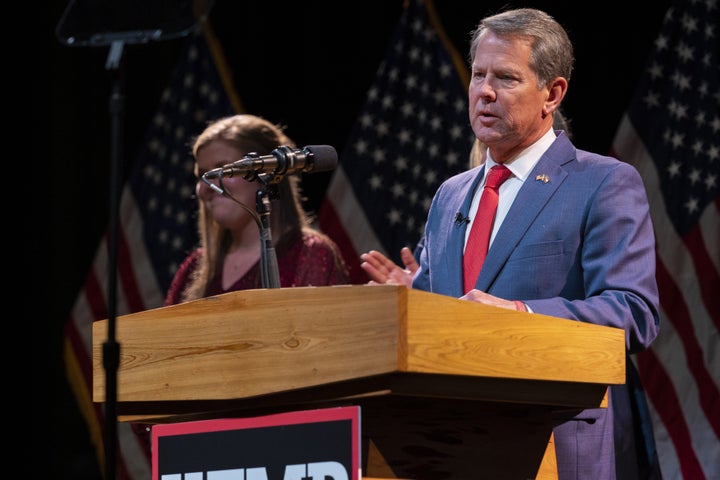A single number can sum up how election night has gone for Democrats: Two.
That’s how many of the party’s incumbents at the House, Senate or gubernatorial levels had lost reelection as of early Wednesday morning. Rep. Elaine Luria, a moderate who represents military-heavy Virginia Beach, Virginia, had fallen to a state Republican lawmaker. And scandal-plagued Rep. Tom Malinowski had lost in New Jersey.
The anticipated red wave of 2022 looks more like the wake generated by a medium-sized fishing boat.
Right now the House still looks likely to enter GOP control, which would be enough for the party to claim victory. But its majority could be small enough that GOP leader Kevin McCarthy would struggle to pass almost any legislation. It remains possible Republicans will not defeat a single Democratic Senate or gubernatorial incumbent and that Democrats could actually add seats in the Senate.
The extent to which Democrats will defy political history is still up in the air: Millions of votes remain to be counted in the coming days, many in key states like Pennsylvania, Nevada and Arizona.
And the reasons why they defied political history seem just as elusive: Abortion rights clearly paid a massive role, but were voters not as worried about crime as surveys made it seem? Was the GOP’s advantage on the economy smaller than it looked at first glance? Did President Joe Biden’s warnings about the threat Republicans posed to democracy go further with voters than anticipated?
In the coming days, we’ll get better answers to these questions. The exit polls, a flawed indicator but the best one available, will be matched to the actual results of the election. The final margins of races will settle. Operatives who did not want to give the game away during the campaign will speak out about what worked, and what didn’t.
The raw exit poll data does provide some tentative answers: While inflation was the No. 1 issue for a 31% plurality of voters, abortion rights was second, with 27% naming it as the most important issue. The gap between the two issues in most pre-election surveys was much larger.
And the advantage Democrats had on abortion rights was larger than the edge Republicans had on inflation: 71% of voters who named inflation as their top issue voted Republican, while 76% of voters who named abortion rights voted Democratic.
Similarly, an identical 11% of voters named either crime or guns as their top issue. The GOP edge on crime was smaller than you might expect: 57% of voters who picked it voted Republican, while 41% voted Democratic. Democrats had a bigger edge on gun policy, with 60% of voters who named it as a top issue backing them and 37% choosing Republicans.
Trump Train Turns Into A Struggle Bus

If the 2022 midterms were the first real test of former President Donald Trump’s influence out of office, then the results were lukewarm at best.
Trump endorsed nearly 40 candidates who won their primaries and advanced to the general election. In many cases, Trump went against the wishes of party leaders and picked candidates he felt were the most loyal to him. There were generally stronger GOP alternatives than the candidates Trump chose.
It’s clear, though, that Trump-endorsed candidates — who generally came with baggage and extreme positions — weren’t the runaway winners of the night. In New Hampshire, Don Bolduc, a Republican who bought into conspiracy theories, lost to incumbent Democratic Sen. Maggie Hassan, setting expectations low for Republicans in other states.
And in Pennsylvania, GOP Senate candidate and former TV host Mehmet Oz lost to Democratic Lt. Gov. John Fetterman in another blow for a Trump pick. Democrat Josh Shapiro also easily whacked Doug Mastriano, a Christian nationalist and extremist election denier whom Trump also endorsed, out of contention for Pennsylvania governor.
Trump candidates also fared poorly in House races. In Ohio, Republican J.R. Majewski, a poorly vetted candidate who lied about his Air Force experience, lost to longtime Democratic Congresswoman Marcy Kaptur. Trump’s blessing helped elevate Majewski in the Republican primary against two state lawmakers who were more likely to beat Kaptur. In Michigan, early results showed Democrat Hillary Scholten leading Trump-backed Republican John Gibbs in a district represented by Republican Peter Meijer, who lost a primary to Gibbs after he voted with Republicans to impeach Trump.
It wasn’t all losses, though. Republican J.D. Vance, who advanced out of a GOP primary with Trump’s help, easily won his Senate race in Ohio. Another Trump Senate nominee, Ted Budd, won in North Carolina.
If Republicans suffer steep losses that prevent them from flipping the House and Senate, then blame the lackluster or downright unelectable MAGA nominees.
Split Tickets Are Back On The Menu

A big question going into Tuesday’s elections centered on whether voters would do something fairly rare in today’s age of negative partisanship: pick and choose candidates from different political parties who are running on the same ballot.
Democratic candidates running for Senate made explicit appeals to independent and Republican voters by touting their bipartisan bona fides and calling out their opponents as extremists. Election results from several Senate and gubernatorial contests suggest many voters found those appeals convincing.
In New Hampshire, for example, Hassan beat Bolduc with the help of GOP voters who also sided with New Hampshire Gov. Chris Sununu at the top of the ticket. Bolduc ran far to the right of the popular GOP governor, spreading conspiracy theories about the 2020 presidential election and LGBTQ individuals.
“You run that far behind your governor candidate, you’re probably making some mistakes,” Sen. Lindsey Graham (R-S.C.) acknowledged in response to Bolduc’s loss in an interview with NBC News.
A similar trend played out in Georgia, where GOP Gov. Brian Kemp outperformed GOP Senate nominee Herschel Walker, a baggage-laden candidate even before the revelations surfaced about him paying for abortions. Kemp cruised to victory in his race over Democrat Stacey Abrams, but Walker’s race against incumbent Democratic Sen. Raphael Warnock was still too close to call early Wednesday morning and may go to a runoff.
And in the Ohio Senate race, Republican Vance defeated Democrat Tim Ryan, though not by as large a margin as some had expected in a state Trump carried overwhelmingly in 2020. Like in New Hampshire and Georgia, the Trump-endorsed Vance underperfomed Republican Gov. Mike DeWine, who easily won reelection.
Incumbent Governors March To Victory
You’ll notice something about many of the candidates who successfully ran ahead of their ticket-mates this cycle: They are incumbent governors. Sununu and Kemp ran well ahead of their party’s Senate candidates. Wisconsin Gov. Tony Evers (D), a far more low-key politician than either Republican, was also running ahead of Mandela Barnes, the party’s Senate candidate.
In fact, it’s possible no incumbent governor loses this cycle. Kansas Gov. Laura Kelley (D) was considered the most vulnerable, and she was on track to eke out a narrow victory over Republican Attorney General Derek Schmidt. Nevada Gov. Steve Sisolak (D), however, was still considered vulnerable in his race against GOP Clark County Sheriff Joe Lombardo.
This is a continuation of a long-standing trend. Just six governor lost reelection bids from 2010 to 2020, and no Democratic governor has lost reelection since 2014.
The trend can also explain why some of the cycle’s bigger names flopped. Stacey Abrams’ job running against incumbent Gov. Brian Kemp was harder than running against him when the seat was open, and that was before accounting for a rougher political environment in 2022 than in 2018. Former Republican Gov. Paul LePage had previously won two elections in Maine but never appeared to seriously threaten Democratic Gov. Janet Mills this cycle.
Democrats Fully Flop In Florida

Republicans absolutely romped in Florida, with Gov. Ron DeSantis defeating Democratic Rep. Charlie Crist by a whopping 20 percentage points, and Sen. Marco Rubio defeating Rep. Val Demings by 16 percentage points.
The pair flipped a slew of traditionally Democratic counties, winning in Miami-Dade and Osceola, both of which are heavily Hispanic. DeSantis also won Democratic-leaning Palm Beach County, while Rubio lost it by less than a percentage point.
DeSantis’ huge win, coupled with the struggles for Trump-endorsed candidates elsewhere, has already prompted the governor’s many, many fans in the conservative media complex to proclaim him one of the bigger winners of this year’s election cycle. And it’s difficult to argue that they’re wrong.
But it’s also worth noting that Democrats barely contested the state. After putting $15 million into Florida between the 2014 and 2018 election cycles, the Democratic Governors’ Association invested substantially less this time around. DeSantis managed to outraise Crist by a more than a 6-to-1 margin, $200 million to $31 million, according to the Miami Herald.
Contrast that with Rubio’s performance after being badly outspent by Demings, who raised $73 million to the incumbent’s $43 million, and it all starts to look a bit less impressive.
The outcome also seems to cement Florida as a red state for the short-term political future, no small development considering it will award 30 electoral votes in the 2024 presidential race.
